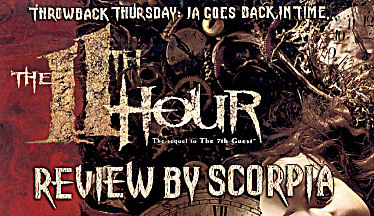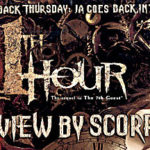
Throwback Thursday – The 11th Hour
This sequel to the 7th Guest invites players to return the Stauf Mansion to solve more puzzles and save a friend in need
Note: Review was originally posted on October 19, 1995.
When I bought a CD-ROM drive a couple years ago, the first game I got for it was The 7th Guest. Despite a few annoying points, I really enjoyed the game. So, when The 11th Hour was announced, I naturally looked forward to its arrival with great eagerness. Now, after many delays, The 11th Hour is on the stands, and it has turned out to be a great disappointment in many ways.
In the first game you wandered through a haunted house, solving puzzles in the various rooms. Completing one or more usually opened more of the house to you, and also triggered ghostly reenactments of what happened in the house back in the ’20s, when Stauf and his six guests mysteriously vanished. Eventually, you made your way to the top of the house for a confrontation with Stauf himself.
There was a lot about The 7th Guest that was never fully (in some cases, not even partially) explained, and many of the ghost scenes were not displayed in order, making the story even harder to follow. This was perhaps the single biggest complaint about The 7th Guest, and evidently the designers took that to heart, as The 11th Hour is a rigidly-linear production.
The story here is about Carl Denning and Robin Morales. Denning is a reporter for and Morales the producer of a TV show called “Case Unsolved.” Morales goes to Harley-On-Hudson to poke around the Stauf mansion and promptly vanishes. Denning receives a palm-sized computer called the “Gamebook,” which shows him a picture of Robin in trouble. Naturally, he jumps right on his motorcycle and heads for the Stauf mansion himself, where he quickly becomes embroiled in Stauf’s little games.
As Denning goes through the house solving the puzzles, the Gamebook shows him playbacks of what happened from the time Morales arrived in town. Some show Morales, some show other people. At the conclusion of each hour, the playbacks from that hour are shown again, in sequence, with some extra scenes. Over the course of the game, the complete narrative is thus developed in order.
The interface is simple, and will be familiar to anyone who’s played The 7th Guest. The main cursor is a skeletal hand, whose motions indicate what you can do. A beckoning or pointing hand means you can go in that direction, while a hand moving rapidly back and forth means no action to be taken. A tapping motion indicates something that can be touched.
The cursor changes to an eyeball over some objects to allow a closer look and becomes a skull with an exposed, pulsating brain when over a puzzle. Pushing the hand to the top of the screen accesses the Gamebook, which is the main control panel. From here, you can save or load the game, quit, look over the house map, review a playback or obtain help from the mysterious Samantha, who sent you the computer in the first place.
The game is divided into the hours of 7, 8, 9, 10, and 11 o’clock (P.M., of course). Everything in each hour must be completed before you can move on to the next one. In many instances, certain puzzles or Treasure Hunts must be solved before more opens to you during a particular hour.
Now that you know something about the game, let’s take a look at what’s wrong with it. First, The 11th Hour was designed not merely for a high-end system, but a top-end one. Where The 7th Guest played flawlessly on my ’66, I couldn’t even bring up The 11th Hour except in quarter-screen grayscale. It was rather like watching a letterbox movie on a black and white TV. There was no deterioration of the graphics, just no color except a tinting of the pieces when doing a puzzle.
Further, the voices on the playbacks were often hard to make out; there was a lot of stuttering and skipping in the audio portion. The game music usually came through all right, however, as did Stauf’s voice. Unfortunately, the music rapidly became boring, as did Stauf’s taunts, and I generally had the speakers off except during the playbacks. None of this added any enjoyment to playing the game.
There are thirteen puzzles in The 11th Hour and six head-to-head confrontations with Stauf in strategy games. Sad to say, most of the puzzles are unimaginative at best. Five of them are of the “switch places” variety. You exchange the starting positions of bishops, knights and spiders (separate puzzles, of course), rearrange books on a shelf, and anagram the letters of “Faust” to “Stauf” on a railroad track. One or two would have been all right; five of essentially the same thing is too much.
Worse yet is the mirror, a form of sliding block puzzle where you have to move the nine panels around to form a complete picture. The puzzle is okay; the problem is that much of the time, you’ll get a starting arrangement that’s impossible to complete, and you won’t know it until you’re well along (the puzzle begins with a random configuration each time).
However, the absolute worst is the Piano. Here, you have a “room” crowded with furniture, and you must move the pieces so you can get the Piano out of the room. Not only is the concept dreary to begin with, it takes something on the order of 90 (!) moves to do it. This isn’t a puzzle, this is stupidity. We all have better things to do with our time than indulge in such tedious exercises.
Beyond the puzzles, there are the Treasure Hunts. In the Hunts, Stauf provides a bizarre clue to some object in the house via the Gamebook. After figuring out the clue, you find the item and touch it. Usually, though not always, this triggers one of the playback scenes.
The clues are in the style of British crosswords, relying heavily on anagrams, puns, homonyms and the like. What is bad about this is you pretty much have to write down all the viewable items in the rooms and hallway or you’ll be a long time finding anything. There’s so much junk lying around, you won’t be able to remember what’s where after awhile, so a list is necessary.
There are more Treasure Hunts than anything else in the game; forty-one of them altogether, and what might have been interesting turns into drudgery before very long. Playing a game should not require taking inventory of the house’s contents. Where’s the fun in this?
The face-offs vs. Stauf were something of a drag for me, since I’m not much of a strategy game player. Fortunately, the AI for these games seems to have been scaled way back from that in the universally-hated microbe puzzle of The 7th Guest (the one thing in that game I used the library book to solve), and it is entirely possible to win all of them with persistence and perhaps a little luck. However, I didn’t particularly care to have to go through six of these things.
Moving around the house is cumbersome and awkward. You’d think that, having a map, you could just click on a room to go there, but that’s not the case. I can see where, for the first visit to an open room, you’d have to go the “hard way.” After that, though, you should have been able to reach such rooms from the house map. It isn’t until the game is over and the entire house is open that you can travel by using the map, and who really cares then?
It’s during play that you really need this ability, and you don’t have it. Instead, you must sit through the tiresome movement system to get anywhere, over and over again. While the house isn’t that large, it still takes awhile to reach most places.
About the story I won’t say too much, because I could go on a long time about it. While the narrative is more connected, it leaves as much if not more unanswered, as did The 7th Guest. Too many things happen without an explanation, which is very unsatisfying.
Moreover, while the story itself starts off interestingly, it soon devolves into something cheap and sordid. And that is really the whole sad point about The 11th Hour: It isn’t so much a game as a third-rate sex and sadism flick masquerading as one. As the events unfolded, I was repelled rather than horrified, and between that and the general tedium of playing, I couldn’t finish this one fast enough.
Overall, The 11th Hour is a mess in its storyline, its poor puzzle quality, its too-high-end requirements, and its general lack of consideration for the game player. I would not recommend this game to anyone.
(Note: I wouldn’t want anyone to get the wrong idea by the mention of “sex.” While some of the scenes are highly suggestive, there is nothing remotely pornographic about them.)
Final Grade: D
System Requirements:
PC:
~IBM and 100% compatibles
~Win 95 or MS-DOS 5.0 or greater
~486DX2/66 minimum (Pentium recommended)
~2x speed CD-ROM drive performing at a sustained rate of 300k/sec
~8 MB RAM, 4 MB hard disk
~Sound Blaster family, Roland family, Media Vision family, Gravis Ultrasound and 100% compatibles
~Local Bus Video capable of displaying thousands of colors
~Microsoft 100% compatible mouse; good, powered speakers.
Mac:
~80mhz PowerPC
~128MB RAM
~System 7.5 or better
~4x CD-ROM

Leave a Reply